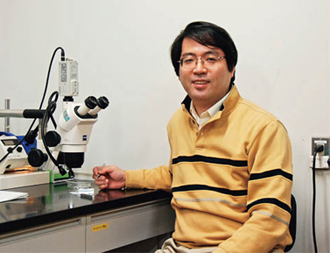Yoshiki Sasai Builds Pituitary Gland from Stem Cells
By wchung | 12 Dec, 2025
Yoshiki Sasai has developed a technique to create transplantable pituitary glands from stem cells.
Yoshiki Sasai has created pituitary glands from scratch and successfully transplanted them into the brains of mice, according to paper published this week in Nature. This feat represents a big leap toward creating the complex organ for transplanting into human patients.
In humans the pituitary gland is a tiny organ, about the size of a pea, and is located at the base of the brain. But it is a crucial part of the endocrine system, producing hormones that regulate growth, blood pressure, energy metabolism, sexual function and the production of breast milk, among other functions. Disruptions in the pituitary have been linked to growth disorders like gigantism, and even blindness.
What makes the pituitary especially difficult to cultivate is that it can only develop through chemical signals from the hypothalamus, the region of the brain just above the pituitary. Using a trial-and-error method Sasai first puzzled out the exact components and sequence of the signaling factors needed to form a pituitary gland. The correct combination required the addition of two growth factors and a drug to stimulate a developmental protein called sonic hedgehog, named after the frenetic character in an old video game. It took two weeks to grow the stem cells into a structure that resembled a pituitary gland.
Sasai’s team used a three-dimensional culture to grow both hypothalamus and pituitary tissues together in the correct physical relationship to each other.
“Using this method, we could mimic the early mouse development more smoothly, since the embryo develops in 3-D in vivo,” said Sasai.
Then Sasai’s team used fluorescence staining to verify that the cultured pituitary tissue expressed the proper biomarkers and secreted the right hormones. To make sure that the synthesized organs were fully functional they were transplanted into mice with pituitary deficits. The transplants restored levels of glucocorticoid hormones in the blood and reversed symptoms like lethargy. A control group of mice implanted with stem-cell constructs that hadn’t been treated with the right signaling factors did not improve, showing that the 3-D structure was crucial to developing functional pituitary glands from stem cells.
Sasai plans to conduct the same experiment with human stem cells, a process that will take about three years. He expects to spend a few more years perfecting transplantation techniques for use in humans.
Yoshiki Sasai is the director of the Nurogenesis & Organogenesis Group at the RIKEN Center for Developmental Biology in Kobe, Japan. Last year his group attracted worldwide attention by building retina-like structures from cultured mouse embryonic stem cells.
Sasai graduated from Kyoto University Medical School with an MD in 1986. He served an internship in general and emergency medicine from 1986 to 1988. From 1988 through 1992 he pursued a PhD course at Kyoto University School of Medicine and earned his PhD in 1993 on the neural specific transcriptional regulators HES family.
From 1993 through 1996 Sasai was a visiting research fellow at UCLA School of Medicine. In 1996 he returned to Kyoto University School of Medicine as an associate professor. From 1998 through 2003 he was a full professor at the Institute for Frontier Medical Sciences at Kyoto University. Simultaneously, he has been a group director at RIKEN Center for Developmental Biology since 2000.
In 2010 Sasai won the Osaka Science Prize for his mechanistic study and in vitro recapitulation of brain development.

RIKEN researcher Yoshiki Sasai has led the development of a technique to grow pituitary glands from stem cells.
Asian American Success Stories
- The 130 Most Inspiring Asian Americans of All Time
- 12 Most Brilliant Asian Americans
- Greatest Asian American War Heroes
- Asian American Digital Pioneers
- New Asian American Imagemakers
- Asian American Innovators
- The 20 Most Inspiring Asian Sports Stars
- 5 Most Daring Asian Americans
- Surprising Superstars
- TV’s Hottest Asians
- 100 Greatest Asian American Entrepreneurs
- Asian American Wonder Women
- Greatest Asian American Rags-to-Riches Stories
- Notable Asian American Professionals

